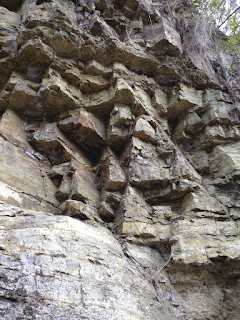As I walk the track each week I collect materials that are scattered and dislodged. From the twigs, leaves and barks I boil up an ink that ranges from a light golden colour to a darker syrup and from the ochres I grind them up into a powder and mix them with water. The environment I walk in is not only the land beneath my feet it is also the pressures beneath that
surface, the cycles of death and decay, the other inhabitants, human and
non-human, my biological responses intertwined with my cultural
affinities.
 |
| Walking the track, collecting natural debris for art materials |
On one side of the tack is Cartwright Creek making its way down to the Derwent River nearby and on the other side is the Dolerite rocks resisting the erosion at a slower pace.
 |
| Dolerite cliff face |
The ochre colours are surprisingly similar to some of the rock faces in the Kimberley, although they are hidden beneath or are seeping out from the dominating grey rock.
 |
| Ochres in the rock face |
As I bring the membrane back each week I gradually add these layers of colours. When the red ochre is isolated and ground up it becomes a dominating force and I pause in my application and start to walk it over the paper.
 |
| Walking through the red ochre |
Whilst the red ochre was applied for its material links to the site, it has an unnerving resonance reminding me of the horrific history of this land. The track is named in memory
of a Nuenonne woman, contentiously called the last Aboriginal Tasmanian. At the pinnacle of the walk is a memorial where you can look over the Derwent River to Bruny Island where Truganini originally lived and where her knowledge base came from.
I
place my roll of imported European paper in the land to act as a membrane between land and
culture, acquiring a memory of past events through the matter of the
environment. Its porous nature shifts
from its cultural tradition as a neutral receptor of representation to a memory
of the interactions between multiple differences, cultural and material. In
working with art as a membrane of memory my aim is to allow a continual
performativity where memory brings forward the past to imagine a better future.
 |
| Looking at the marks |
As I look at the marks, the red ochre becomes too opaque, obliterating the marks below, so I place the roll in a large tub, gently washing the paper. Through this the materials are taken off the surface but stain and seep into the membrane.
 |
| After a wash |


No comments:
Post a Comment